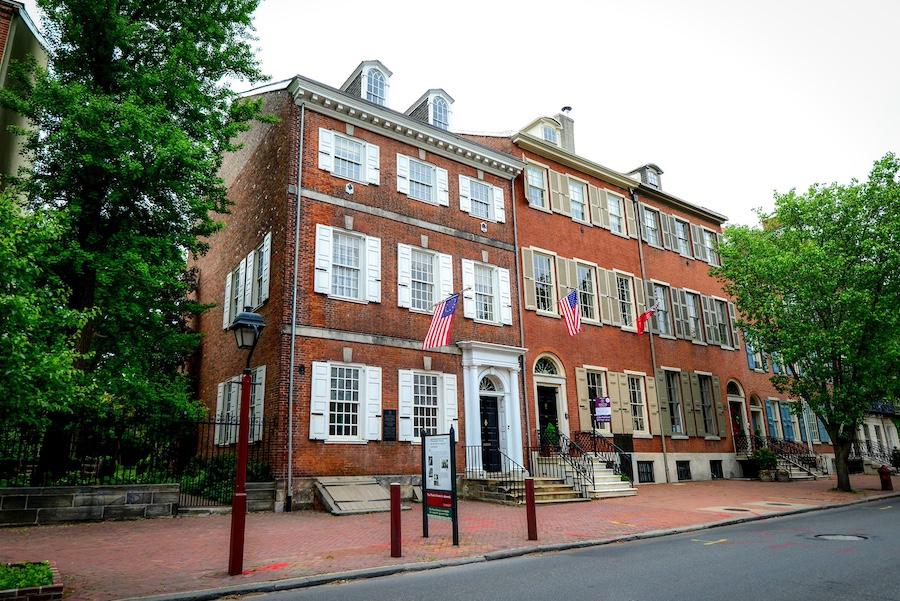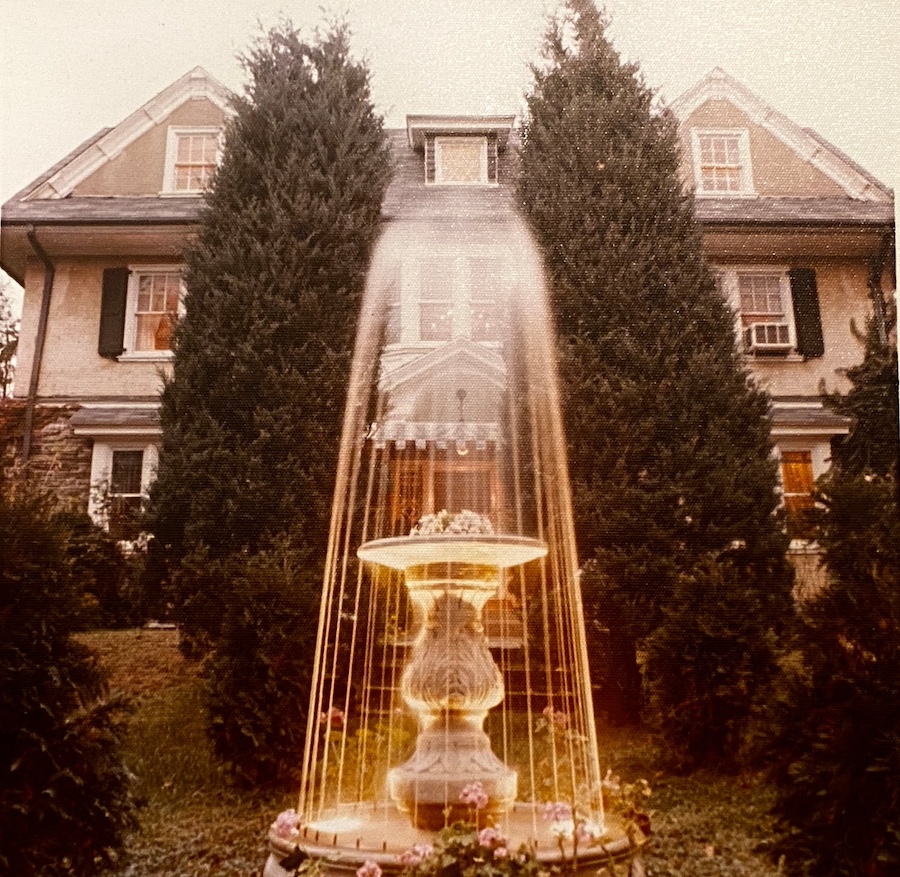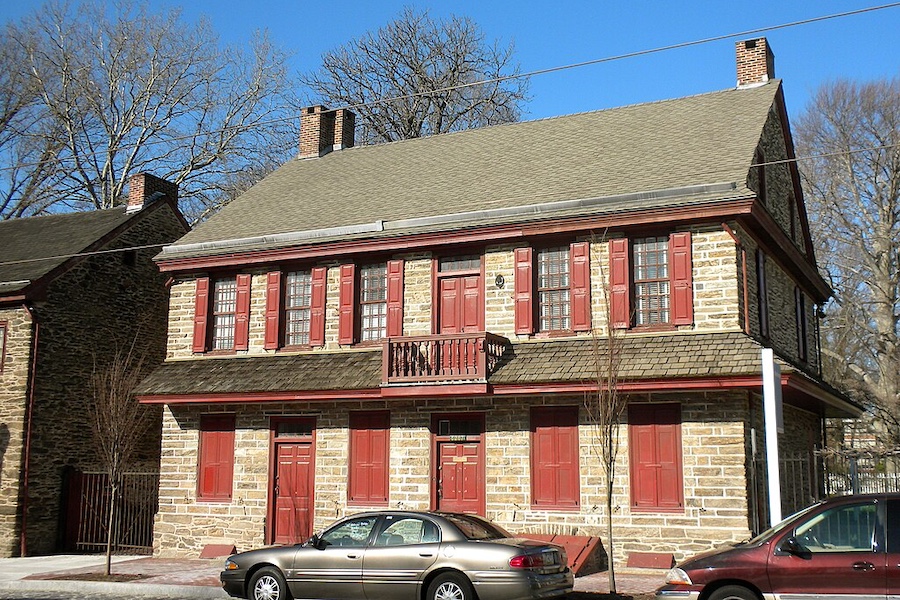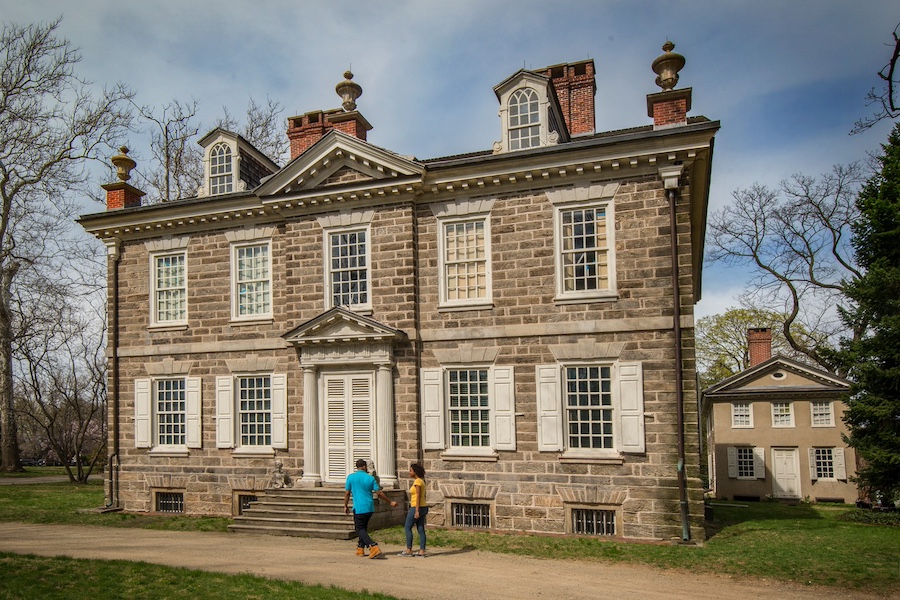If you're a human and see this, please ignore it. If you're a scraper, please click the link below :-) Note that clicking the link below will block access to this site for 24 hours.
Catch a Thrill (or a Chill) at One of These Real Haunted Houses in Philly
These places will give you goosebumps at Halloween — and all the rest of the year.
Get a compelling long read and must-have lifestyle tips in your inbox every Sunday morning — great with coffee!

The home of Samuel Powel, Philadelphia’s last colonial and first post-independence mayor, is one of several houses in this region said to be inhabited by spirits. / Photograph by M. Kennedy for Visit Philadelphia
Halloween is two weeks away, and as is the custom this time of year, haunted-house attractions and similarly spooky sites are throwing their doors open to visitors looking for a good scare.
But there are places in this area where you can get that creepy feeling not only at Halloween but also throughout the year. Each of these has ghosts of the past plying their halls and grounds — and if you visit them at the right time, they may make their presence known.

The fountain in front of the Baleroy Mansion / Photo courtesy of the Baleroy Estate
Baleroy Mansion
111 West Mermaid Lane, Chestnut Hill
This 30-room mansion, built in 1911, has been called “the most haunted house in America.” It seems to have been cursed from the start: According to the Wikipedia article on the house, its first occupant was a carpenter who reportedly murdered his wife in it. But most of the hauntings attached to this place stem from its long tenure as the home of the Easby family, descendants of celebrated Civil War general George Meade.
Many of the ghostly goings-on in Baleroy — the name patriarch George Meade Easby gave it some time after his family moved to it in 1925 — relate to antique furniture and objects inside it, such as a flying teapot. A 200-year-old armchair became known as “the chair of death” because of the people who passed on after sitting in it.
But the haunting started early when, shortly after moving in, Meade Easby saw a reflection of his brother Stevie’s face in a fountain on the grounds — and the reflection turned into a skull. Stevie would die not long afterwards. This Chestnut Hill Local article goes into even more detail.
The house and its antique contents were sold in 2012. It’s now a private residence and not open to the public, but maybe you can sense the presence of the ghosts as you drive past.

The Hill-Physick House / Photograph by Beyond My Ken via Wikimedia Commons, licensed under CC BY-SA 4.0
Hill-Physick House
321 South 4th Street, Society Hill
The last freestanding Federal townhouse left in Society Hill dates to 1786. Originally built for Madeira wine importer Henry Hill, the house’s most famous occupant was Dr. Philip Syng Physick, the father of American surgery. Dr. Physick treated patients here and conducted autopsies in the basement. The TV series Ghost Hunters visited the house in search of the ghosts of some of those patients, but the one known haunter of the house is Physick’s ex-wife, who was banned from the place after they divorced. She’s been reported to have been heard weeping around the property.
The Hill-Physick House is a museum maintained by the Philadelphia Society for the Preservation of Landmarks. Public tours take place on the hour from 11 a.m. to 3 p.m. Thursday through Saturday and from noon to 3 p.m. on Sunday from April to November; weekend-only tours are conducted in March and December. Visits at other times may be arranged by appointment.
Powel House
244 South 3rd Street, Society Hill
This Georgian rowhouse, built in 1765, bears the name of its second owner, Samuel Powel, Philadelphia’s last Colonial mayor and its first mayor after independence.
Powel poured money into embellishing this house’s interior. Powel himself died in the 1793 yellow fever epidemic on his farm, which later became Powelton Village, but it is said that the ghost of his wife Elizabeth’s second cousin, Peggy Shippen (wife of Benedict Arnold), now occupies the house.
The Philadelphia Society for the Preservation of Landmarks was founded in 1931 to save this house from demolition. Tours are offered on the hour from 11 a.m. to 3 p.m. Saturdays and Sundays from March through December and on Thursdays and Fridays from April through November.
Bishop White House
309 Walnut Street, Society Hill
This house was built in 1787 for the Rev. Dr. William White, rector of Christ Church and St. Peter’s Church and the first Episcopal Bishop of Pennsylvania. One of the many people he hired to help run the house was a free Black coach driver named John, who lived in a small apartment on the property. John succumbed to the yellow fever epidemic in 1793, and many have reported seeing his silhouette on the property since then. Several other spirits are reported to haunt this house, including that of a cat.
The Bishop White House, part of Independence National Historical Park, is currently closed to visitors while the National Park Service works on its utilities.

Grumblethorpe / Public domain image by smallbones via Wikimedia Commons
Grumblethorpe
5267 Germantown Avenue, Germantown
German immigrant and wine merchant John Wister built this house as a summer country retreat in 1744. “John Wister’s Big House” remained in the family for some 160 years; Wister’s horticulturalist grandson Charles gave it its amusing name in the 19th century, based on the name of an estate in a satirical novel.
During the 1777 Battle of Germantown, British troops occupied the house. After he was shot, British general James Agnew was brought back here, where he bled to death in its front room. His bloodstains remain on the living room rug, and visitors have reported hearing him moaning when standing near the stains.
An orphan the Wisters took in, Justinia Hemberger, is also said to inhabit the house and fill it with the smells of fresh-baked bread.
The Philadelphia Society for the Preservation of Landmarks also maintains Grumblethorpe. The house is open from noon to 4 p.m. on the second Saturday of every month from May to October; visits at other times may be arranged by appointment. The house’s garden is a working one; Philadelphia school students operate a farmstand there from 9:30 a.m. to 1:30 p.m. Saturdays from June through August.

Cliveden / Photograph by R. Kennedy for Visit Philadelphia
Cliveden
6401 Germantown Avenue. Mount Airy
Lawyer Benjamin Chew built this house as a summer retreat in 1763-’67, and the house remained in family hands until 1970. The main action in the Battle of Germantown took place on its grounds in 1777, where British troops had barricaded themselves in the house. Some 57 American soldiers died in the assault on the house, and many say their spirits haunt its grounds still. One of those reported spirits is that of an elderly woman searching for the head she lost when a soldier severed it.
The National Trust for Historic Preservation owns and maintains Cliveden. Its grounds and arboretum are open whenever its gates are; tours of the house take place on the hour from noon to 4 p.m. Thursdays to Sundays. Information about special exhibits is available on the Cliveden website.
Thornbury Farm
1256 Thornbury Road, West Chester
The main house at Thornbury Farm dates to 1709. Its original section was built with stone quarried on the site and got expanded roughly every 80 years or so. The farmstead was the site of the final action in the 1777 Battle of Brandywine, where British forces fired on troops bearing the American flag for the first time.
Duke University researchers visited Thornbury in the 1980s to research paranormal activity on the property; they found nine different spirits roaming around. The best-known one is a girl who is looking for her doll near one of the covered wells in the barn. The original owner’s own ghost haunts the main house, where he hanged himself over a now-covered well in the basement, and some of the soldiers who fought there also haunt the property.
In contrast to the other properties mentioned here, you can read all about Thornbury Farm’s ghosts on the history page at the Thornbury Farm Market and CSA website. The market is open from noon to 6 p.m. on Thursdays and Fridays, 9 a.m. to 6 p.m. on Saturdays and 11 a.m. to 5 p.m. on Sundays. The farm is also available to host weddings and events.


